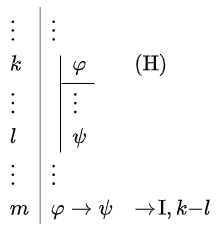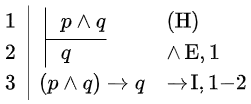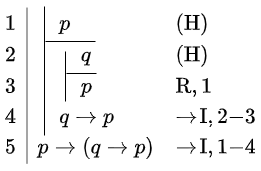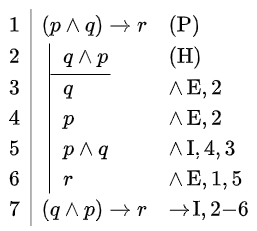Propositional Logic: Natural deduction
 Implication reasoning rules and the repetition rule
Implication reasoning rules and the repetition rule
Introduction rule for implication The introduction rule \(\rightarrow\!\mathrm{I}\) for the connective \(\rightarrow\) is as follows:

This means that if we assume the hypothesis \(\varphi\), then the formula \(\varphi\rightarrow \psi\) can be derived in a subproof. The formulas in line \(k\) through \(l\) are not available outside this subproof, but in line \(l+1\) we mention them only to indicate the scope of the subproof. Strictly speaking, we can do without line numbers because the vertical line already indicates when the subproof ends and the conclusion \(\varphi\rightarrow \psi\) is drawn.
The repetition rule The repetition rule, denoted by the letter R for repetition, is as follows: \[\begin{array}{l|ll}\vdots & \vdots & \\ k & \varphi & \\ \vdots & \vdots \\ l & \varphi & \mathrm{R}, k\end{array}\] With this, in a later stage of a derivation, you can repeat any formula that is not a hypothesis that has already been withdrawn or depends on such a hypothesis. In other words, formulas can be repeated from a main proof to a subproof, but not the other way around.
Examples
| \(\vdash (p\land q)\rightarrow q\) | \(\vdash p\rightarrow (q\rightarrow p)\) | \((p\land q)\rightarrow r \vdash (q\land p)\rightarrow r\) |
 |
 |
 |
Elimination rule for implication The elimination rule \(\rightarrow\!\mathrm{E}\) for the connective \(\rightarrow\) is as follows:
| \[\begin{array}{l|ll} \vdots & \vdots &\\ k &\varphi\rightarrow\psi & \\ \vdots & \vdots & \\ l &\varphi & \\ \vdots & \vdots & \\ m & \psi & \rightarrow\!\mathrm{E}, k, l \end{array}\] | \[\begin{array}{l|ll} \vdots & \vdots &\\ k &\varphi & \\ \vdots & \vdots & \\ l &\varphi\rightarrow \psi & \\ \vdots & \vdots & \\ m & \psi & \rightarrow\!\mathrm{E}, k, l \end{array}\] |
The elimination rule is also known as Modus Ponens: From \(\varphi\rightarrow \phi\) it follows, if \(\varphi\) is available, that the conclusion \(\psi\) can be drawn.
Examples
| \(p\rightarrow q, p\vdash q\) | \( p\land r, r\rightarrow q\vdash p\land q\) | \(\bigl(p\rightarrow (q\rightarrow r)\bigr), p\rightarrow q, p \vdash r\) |
| \[\begin{array}{l|ll} 1 & p\land q & (\mathrm{P})\\ 2 & p & (\mathrm{P})\\ 3 & q & \rightarrow\!\mathrm{E}, 1, 2\end{array}\] |
\[\begin{array}{l|ll} 1 & p\land r & (\mathrm{P})\\ 2 & r\rightarrow q & (\mathrm{P})\\ 3 & p & \land\,\mathrm{E}, 1\\ 4 & r & \land\,\mathrm{E}, 1\\ 5 & q& \rightarrow\!\mathrm{E}, 2, 4\\ 6 & p\land q & \land\,\mathrm{I}, 3,5\\ \end{array}\] |
\[\begin{array}{l|ll} 1 &p\rightarrow (q\rightarrow r) & (\mathrm{P})\\ 2 & p\rightarrow q & (\mathrm{P})\\ 3 & p & (\mathrm{P})\\ 4 & q & \rightarrow\!\mathrm{E}, 2,3\\ 5 & q\rightarrow r & \rightarrow\!\mathrm{E}, 1,3\\ 6 & r & \rightarrow\!\mathrm{E}, 4,5 \end{array}\] |


